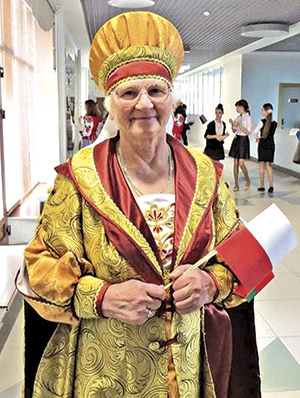
Festival in Slonim bright and colourful in every fashion
|
Greeting visitors of the festival, Mr. Targonsky could not resist declaring, “In its years of existence, the festival has hosted hundreds of unforgettable works from its stage. Noble gentlemen have been creating an incomparable atmosphere since time immemorial, dancing with their chosen ones, with great feeling. This is a real holiday, uniting deep respect for the present and the past, in our Slonim District.”
In 2004, when the first festival was held, it had a narrower scope than today, explains Leonarda Revkovskaya, the Chair of the Slonim Department of the Union of Poles in Belarus, who initiated the foundations of the holiday. She recollects with a smile how she paid the expenses of the event, nurturing the festival to life. She explains that, these days, street traffic is stopped for the celebratory procession. Originally, those few parading simply used the pavements, manoeuvring between passers-by. No longer so modest, the event is popular with guests from Poland and Belarus, as well as others from abroad. This year, 22 participants joined the festival, including those from foreign nations. She tells us, “I’m very grateful to regional and district executive committees for having supported the idea, and for undertaking the lion’s share of expenses and organisational efforts. We, Poles of Belarus, now have a good platform from which to develop our culture.”
Visitors from Polish Bielsk Podlaski fully agree, having received a great ovation for their Vasilechki folk group. Participants have been acquainting Poles with Belarusian culture for the past 50 years and believe it to be no less important to popularise Polish culture in Belarus. The Art Director of Vasilechki, Nikolay Fadin, is convinced that neither diaspora should forget its roots. He underlines, “We are representatives of the Belarusian diaspora in Poland, with a repertoire of Belarusian songs. On receiving an invitation to the festival of Polish culture, we didn’t hesitate, performing a Polish song at the combined concert, while reserving the rest for our solo concert.”
Recently, Ms. Revkovskaya received an invitation to go to Warsaw, for the first Polish polonaise festival. The Warsaw dance group comes to Slonim every year, so its participants decided to organise a similar activity in Poland. “It turns out that Slonim not only learns from Warsaw, but Warsaw learns from us,” smiles Leonarda.
By Katerina Charovskaya











